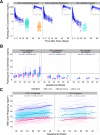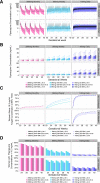Piperaquine Exposure Is Altered by Pregnancy, HIV, and Nutritional Status in Ugandan Women
- PMID: 33020153
- PMCID: PMC7674024
- DOI: 10.1128/AAC.01013-20
Piperaquine Exposure Is Altered by Pregnancy, HIV, and Nutritional Status in Ugandan Women
Abstract
Dihydroartemisinin-piperaquine (DHA-PQ) provides highly effective therapy and chemoprevention for malaria in pregnant African women. PQ concentrations of >10.3 ng/ml have been associated with reduced maternal parasitemia, placental malaria, and improved birth outcomes. We characterized the population pharmacokinetics (PK) of PQ in a post hoc analysis of human immunodeficiency virus (HIV)-infected and -uninfected pregnant women receiving DHA-PQ as chemoprevention every 4 or 8 weeks. The effects of covariates such as pregnancy, nutritional status (body mass index [BMI]), and efavirenz (EFV)-based antiretroviral therapy were investigated. PQ concentrations from two chemoprevention trials were pooled to create a population PK database from 274 women and 2,218 PK observations. A three-compartment model with an absorption lag best fit the data. Consistent with our prior intensive PK evaluation, pregnancy and EFV use resulted in a 72% and 61% increased PQ clearance, compared to postpartum and HIV-uninfected pregnant women, respectively. Low BMI at 28 weeks of gestation was associated with increased clearance (2% increase per unit decrease in BMI). Low-BMI women given DHA-PQ every 8 weeks had a higher prevalence of parasitemia, malaria infection, and placental malaria compared to women with higher BMIs. The reduced piperaquine exposure in women with low BMI as well as during EFV coadministration, compared to pregnant women with higher BMIs and not taking EFV, suggests that these populations could benefit from weekly instead of monthly dosing for prevention of malaria parasitemia. Simulations indicated that because of the BMI-clearance relationship, weight-based regimens would not improve protection compared to a 2,880 mg fixed-dose regimen when provided monthly. (The clinical trials described in this paper have been registered at ClinicalTrials.gov under identifiers NCT02163447 and NCT02282293.).
Keywords: dihydroartemisinin-piperaquine; drug-drug interactions; malaria prevention; pharmacokinetics; population pharmacokinetics; pregnancy.
Copyright © 2020 American Society for Microbiology.
Figures





Similar articles
-
Predicting Optimal Dihydroartemisinin-Piperaquine Regimens to Prevent Malaria During Pregnancy for Human Immunodeficiency Virus-Infected Women Receiving Efavirenz.J Infect Dis. 2018 Mar 5;217(6):964-972. doi: 10.1093/infdis/jix660. J Infect Dis. 2018. PMID: 29272443 Free PMC article.
-
Modeling Prevention of Malaria and Selection of Drug Resistance with Different Dosing Schedules of Dihydroartemisinin-Piperaquine Preventive Therapy during Pregnancy in Uganda.Antimicrob Agents Chemother. 2019 Jan 29;63(2):e01393-18. doi: 10.1128/AAC.01393-18. Print 2019 Feb. Antimicrob Agents Chemother. 2019. PMID: 30530597 Free PMC article. Clinical Trial.
-
Efavirenz-Based Antiretroviral Therapy but Not Pregnancy Increased Unbound Piperaquine Exposure in Women during Malaria Chemoprevention.Antimicrob Agents Chemother. 2023 Apr 18;67(4):e0142722. doi: 10.1128/aac.01427-22. Epub 2023 Mar 14. Antimicrob Agents Chemother. 2023. PMID: 36916944 Free PMC article.
-
Piperaquine-Induced QTc Prolongation Decreases With Repeated Monthly Dihydroartemisinin-Piperaquine Dosing in Pregnant Ugandan Women.Clin Infect Dis. 2022 Aug 31;75(3):406-415. doi: 10.1093/cid/ciab965. Clin Infect Dis. 2022. PMID: 34864925 Free PMC article. Clinical Trial.
-
Antiretroviral Therapy With Efavirenz Accentuates Pregnancy-Associated Reduction of Dihydroartemisinin-Piperaquine Exposure During Malaria Chemoprevention.Clin Pharmacol Ther. 2017 Sep;102(3):520-528. doi: 10.1002/cpt.664. Epub 2017 May 30. Clin Pharmacol Ther. 2017. PMID: 28187497 Free PMC article. Clinical Trial.
Cited by
-
Pharmacokinetics of piperaquine and its association with intermittent malaria preventive therapy outcomes during pregnancy.BMC Pharmacol Toxicol. 2024 Jul 8;25(1):38. doi: 10.1186/s40360-024-00762-6. BMC Pharmacol Toxicol. 2024. PMID: 38978151 Free PMC article.
-
Acceptability of intermittent preventive treatment of malaria in pregnancy with sulfadoxine-pyrimethamine plus dihydroartemisinin-piperaquine in Papua New Guinea: a qualitative study.Malar J. 2025 Jan 13;24(1):13. doi: 10.1186/s12936-024-05233-1. Malar J. 2025. PMID: 39806485 Free PMC article.
-
Interplay among malnutrition, chemoprevention, and the risk of malaria in young Ugandan children: Longitudinal pharmacodynamic and growth analysis.CPT Pharmacometrics Syst Pharmacol. 2023 May;12(5):656-667. doi: 10.1002/psp4.12892. Epub 2023 Mar 14. CPT Pharmacometrics Syst Pharmacol. 2023. PMID: 36919202 Free PMC article. Clinical Trial.
-
Drug-Drug Interaction Between Dihydroartemisinin-Piperaquine and Sulfadoxine-Pyrimethamine During Malaria Chemoprevention in Pregnant Women.Clin Pharmacol Ther. 2025 Feb;117(2):506-514. doi: 10.1002/cpt.3471. Epub 2024 Oct 14. Clin Pharmacol Ther. 2025. PMID: 39402742 Clinical Trial.
-
Piperaquine Pharmacokinetics during Intermittent Preventive Treatment for Malaria in Pregnancy.Antimicrob Agents Chemother. 2021 Feb 17;65(3):e01150-20. doi: 10.1128/AAC.01150-20. Print 2021 Feb 17. Antimicrob Agents Chemother. 2021. PMID: 33361303 Free PMC article.
References
-
- World Health Organization. 2019. World Malaria Report 2019. World Health Organization, Geneva, Switzerland: https://www.who.int/publications/i/item/9789241565721.
-
- Akinyemi RO, Izzeldin IM, Dotchin C, Gray WK, Adeniji O, Seidi OA, Mwakisambwe JJ, Mhina CJ, Mutesi F, Msechu HZ, Mteta KA, Ahmed MA, Hamid SH, Abuelgasim NA, Mohamed SA, Mohamed AY, Adesina F, Hamzat M, Olunuga T, Maro VP, Walker R. 2014. Contribution of noncommunicable diseases to medical admissions of elderly adults in Africa: a prospective, cross-sectional study in Nigeria, Sudan, and Tanzania. J Am Geriatr Soc 62:1460–1466. doi:10.1111/jgs.12940. - DOI - PubMed
-
- Moore KA, Fowkes FJI, Wiladphaingern J, Wai NS, Paw MK, Pimanpanarak M, Carrara VI, Raksuansak J, Simpson JA, White NJ, Nosten F, McGready R. 2017. Mediation of the effect of malaria in pregnancy on stillbirth and neonatal death in an area of low transmission: observational data analysis. BMC Med 15:98. doi:10.1186/s12916-017-0863-z. - DOI - PMC - PubMed

